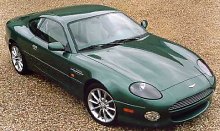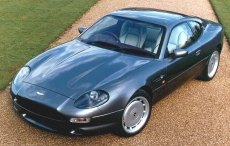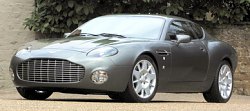DB7 Vantage
 Since
the arrival of Jaguar XKR coupe, Aston's money making flagship, DB7,
found
itself in an embarrassing position. Both Aston Martin and Jaguar are
the
subsidiary of Ford. The XKR is intended to be a mass production
luxurious
coupe. In addition to its non-supercharged version XK8, its annual
production
rate is around 10,000 units. Aston DB7 is quite different. Since 1994,
every year the British speciality sell 400-600 DB7s, all of which are
made
without robots. The price tag also reflects Ford's intention to place
the
Aston above Jaguar - in UK, DB7 sells at £85,000 while the XKR is
on offer at £60,000. Nevertheless, the XKR is powered by a
supercharged
4.0 V8 capable of 370hp, while DB7's unit is just a supercharged 3.2
inline
six rated at 335hp. Worst of all, the straight six was actually derived
from Jaguar's contemporary AJ6 engine. Don't you think there's anything
wrong ? Since
the arrival of Jaguar XKR coupe, Aston's money making flagship, DB7,
found
itself in an embarrassing position. Both Aston Martin and Jaguar are
the
subsidiary of Ford. The XKR is intended to be a mass production
luxurious
coupe. In addition to its non-supercharged version XK8, its annual
production
rate is around 10,000 units. Aston DB7 is quite different. Since 1994,
every year the British speciality sell 400-600 DB7s, all of which are
made
without robots. The price tag also reflects Ford's intention to place
the
Aston above Jaguar - in UK, DB7 sells at £85,000 while the XKR is
on offer at £60,000. Nevertheless, the XKR is powered by a
supercharged
4.0 V8 capable of 370hp, while DB7's unit is just a supercharged 3.2
inline
six rated at 335hp. Worst of all, the straight six was actually derived
from Jaguar's contemporary AJ6 engine. Don't you think there's anything
wrong ?
To rescue Aston's
image,
DB7 Vantage was born. My memory tells me the "Vantage" name was first
used
in the 70's, representing a super fast Aston V8. In then, its 170mph
top
speed and 5.4sec for 0-60 made it the fastest British car. Aston uses
the
name again in the current V8 Vantage, a car based on Virage but powered
by a 550hp supercharged V8. This name always represent the hottest
version
of an Aston, just like BMW's M badge.
Not least of
which is the
DB7 Vantage. To be better than Jaguar (at least in terms of image), it
features Aston's first ever V12 - a 48 valves unit displacing nearly 6
litres. The exact capacity is 5935c.c., maximum output is 420hp and 400
lbft, sufficient to eclipse the Jaguar's 370hp and 387lbft. Aston said
it could top 185mph and sprint to 60mph from standstill in 5 seconds
flat.
If the acceleration is not much better than Jaguar's 5.1sec, at least
its
top speed is considerably higher than Jaguar's electronic limited
155mph.
Of course, V12
must have
a superior image over a V8. The former is reserved for only Italian
supercars,
the latter can be found in every American muscle cars. However, if you
know DB7's unit is actually derived from a bread-and-butter Ford
Taurus,
what would you think ? If you still remember Ford's stunning
(stunningly
ugly) Indigo concept supercar shown in 3 years ago, you must know its
6-litre
V12 was made by mating two Duratec 3-litres V6 together. Base on this
engine,
Cosworth Engineering developed it into the Aston V12. Basically there's
nothing spectacular - no variable valve timing, no variable induction,
no titanium connecting rod.... but there is a lot of capacity. Even
though
the peak torque occurs at 5,000 rpm, at least 85% of which is available
as low as 1,500rpm. This is very enough for a effortless and fast Grand
Tourer.
To accommodate
the V12 is
not a big problem, as it has the same length as the straight six.
Engineers
only enlarged the transmission tunnel, revise the nose and bumpers to
enable
a larger air intake. A sub-product is slightly, 5% increase of
torsional
rigidity to the chassis. As in before, the chassis is made of steel
monocoque,
covering with aluminium body panels, composite bonnet and boot lid.
However,
engineers took this
chance to improve DB7's handling. Front suspensions received new-style
wishbones and a new vertical link. Springs in all wheels were stiffened
by 15-20%. Then revised the gear ratio of the rack and pinion steering
to quicken the steering response from 2.7 turns to 2.5 turns lock to
lock.
Mated to the V12
is a 6-speed
manual made by Borg Warner, or alternatively a 5-speed ZF automatic. I
believe most customers will choose the latter. As it has more power, as
the weight increased to 1780kg, Brembo cross-drilled ventilating disc
brakes,
front diameter 355mm, rear 330mm, are adopted. 18 inches alloy wheels
are
also new item.
Seats and
instrument are
also redesigned, but our focus is still on its engine and handling.
Obviously,
the V12 makes much better noise than the supercharged straight six. Its
beautiful song persuade you to accept the price hike of £20,000.
It pulls smoothly and strongly, delivering high performance (not really
in supercar territory) effortlessly. The new suspensions and steering
set
up sharpen its handling quite a lot. Not only steers quicker, but the
huge
body could be accurately controlled.
Although the
improvement
could not be described as a breakthrough, DB7 Vantage still has a
pretty
good prospect. In its price range, direct competitors are limited to
Ferrari
F355 / 360 Modena and Porsche's forthcoming 911 turbo, but both of them
are more performance-biased. The greater threat is Ferrari 550M, which
is priced some £45,000 above the Aston. Of course it's not a
direct
competitor.
Versus
Ferrari 550 Maranello
Although DB7 Vantage
is not
priced to compete with Ferrari's mighty 550M, it is still worthy to see
how they compare. Bearing in mind the DB7 is not a traditional Aston,
you
won't be too surprised that this Aston is so similar to the Ferrari
flagship
- both are front-engined, rear-drive GT and powered by a large V12 with
400-excess horsepower. In our memory, the Aston should be V8-powered.
Fire the
Cosworth-cast V12
and you'll hear a wonderful yowl which is not just the summation of 2
Duratec
V6s. The hollow, multi-layer sound resembles the mighty Daytona even
more
than the 550M. While the 6-litre capacity feels torquey at low and mid
range, it is left away by the Ferrari's 65hp advantage at high speed.
The
Maranello engine feels much more sporty, pulls strongly across all the
rev. It still sings beautifully and spins eagerly at red line, which is
not the Aston can match.
But the Aston
wins the braking
match. Despite of being 90kg heavier, it has larger Brembo discs all
round
: 355mm diameter in front versus Ferrari's 330mm, 330mm at the rear
versus
318mm. Braking power is stronger yet the pedal feels progressive.
The Aston rides
on softer
suspensions setting, hence a supple ride but less sporty handling. The
chassis seems not as tightly controlled as the Ferrari. The less
aggressive
tyres obviously generate less grip. Worst of all, although the steering
is well-weighted it feels dull and lacks communication that a truly
exciting
car deserves. While 550M feels like a leopard the Vantage is more like
a sleepy lion.
After all, the
Aston is not
intended to be a focused sports car as the Ferrari. Its customers are
those
mature riches wanting prestige yet a relax motoring experience. Drive
the
DB7 Vantage day to day is deemed to be a joy. Doing the same to the
Ferrari
always require more effort and an enthusiasm.
However, it is
not said the
DB7 Vantage has scored the highest marks in the fields it ought to be.
The quality of craft, the material used and the design in the cabin are
actually lower than Ferrari. This is also why I said it is not a
traditional
Aston.
|
 DB7
is not an ordinary Aston Martin. In fact, it was designed and built by
TWR, powered by a Jaguar engine and funded by Ford ( who own Aston ).
If
it were designed and built by Aston itself, it would not have been so
good
and so successful. Just see Virage and you'll know.
DB7
is not an ordinary Aston Martin. In fact, it was designed and built by
TWR, powered by a Jaguar engine and funded by Ford ( who own Aston ).
If
it were designed and built by Aston itself, it would not have been so
good
and so successful. Just see Virage and you'll know.
 Since
the arrival of Jaguar XKR coupe, Aston's money making flagship, DB7,
found
itself in an embarrassing position. Both Aston Martin and Jaguar are
the
subsidiary of Ford. The XKR is intended to be a mass production
luxurious
coupe. In addition to its non-supercharged version XK8, its annual
production
rate is around 10,000 units. Aston DB7 is quite different. Since 1994,
every year the British speciality sell 400-600 DB7s, all of which are
made
without robots. The price tag also reflects Ford's intention to place
the
Aston above Jaguar - in UK, DB7 sells at £85,000 while the XKR is
on offer at £60,000. Nevertheless, the XKR is powered by a
supercharged
4.0 V8 capable of 370hp, while DB7's unit is just a supercharged 3.2
inline
six rated at 335hp. Worst of all, the straight six was actually derived
from Jaguar's contemporary AJ6 engine. Don't you think there's anything
wrong ?
Since
the arrival of Jaguar XKR coupe, Aston's money making flagship, DB7,
found
itself in an embarrassing position. Both Aston Martin and Jaguar are
the
subsidiary of Ford. The XKR is intended to be a mass production
luxurious
coupe. In addition to its non-supercharged version XK8, its annual
production
rate is around 10,000 units. Aston DB7 is quite different. Since 1994,
every year the British speciality sell 400-600 DB7s, all of which are
made
without robots. The price tag also reflects Ford's intention to place
the
Aston above Jaguar - in UK, DB7 sells at £85,000 while the XKR is
on offer at £60,000. Nevertheless, the XKR is powered by a
supercharged
4.0 V8 capable of 370hp, while DB7's unit is just a supercharged 3.2
inline
six rated at 335hp. Worst of all, the straight six was actually derived
from Jaguar's contemporary AJ6 engine. Don't you think there's anything
wrong ?
 After
the famous DB4GT of the 60s and the controversial V8 Zagato of the
mid-80s,
Italian styling house / coach-builder Zagato once again team up with
Aston
Martin to produce a limited edition, this time base on DB7
Vantage.
After
the famous DB4GT of the 60s and the controversial V8 Zagato of the
mid-80s,
Italian styling house / coach-builder Zagato once again team up with
Aston
Martin to produce a limited edition, this time base on DB7
Vantage.
 Aston
also tweaked the 6-litre V12 engine slightly, reprogrammed the ECU and
using sportier exhaust to generate another 20 horsepower - now 440hp,
20
shy of Vanquish. To improve acceleration further, final drive ratio has
been increased from 3.77: 1 to 4.09:1. There is also modified LSD,
firmer
suspension setup and stronger brakes to enhance performance. Aston
claims
0-60mph is reduced to less than 5 seconds, while top speed is 190mph.
Aston
also tweaked the 6-litre V12 engine slightly, reprogrammed the ECU and
using sportier exhaust to generate another 20 horsepower - now 440hp,
20
shy of Vanquish. To improve acceleration further, final drive ratio has
been increased from 3.77: 1 to 4.09:1. There is also modified LSD,
firmer
suspension setup and stronger brakes to enhance performance. Aston
claims
0-60mph is reduced to less than 5 seconds, while top speed is 190mph.
 Like
wine, DB7 just get better and better as time goes by. At its 6-year-old
birthday, Aston Martin gave it a V12 engine. 3 years later, a Zagato
edition
was born. Today, already 10 years old, a more driver-focused GT version
is launched. The DB7 GT corrected many flaws of the old car and lifted
it right to the level of Ferrari 575M. In some areas, it is even better.
Like
wine, DB7 just get better and better as time goes by. At its 6-year-old
birthday, Aston Martin gave it a V12 engine. 3 years later, a Zagato
edition
was born. Today, already 10 years old, a more driver-focused GT version
is launched. The DB7 GT corrected many flaws of the old car and lifted
it right to the level of Ferrari 575M. In some areas, it is even better.
 On
the road, the DB7 GT accelerates stronger, finishing 0-60mph in 5.0
seconds
or 0.2 sec quicker than before.
That is a
decisive 0.8 seconds behind the
Ferrari, but the exhaust note of the Aston V12 beats the
Ferrari
in sound
quality and volume so that subjectively it feels not much slower. The
gearshift
is now a joy to use, with short throw and nice mechanical feel. Braking
is strong and confidence inspiring, although the nose still dive under
braking. Steering feel is greatly improved - communicative, accurate,
meaty
and free of kickback, actually better than the
Ferrari.
Not so the body
control. 575M still has a better balanced chassis and sharper response,
but the GT is already a big improvement from the Vantage. It changes
direction
more eager and rolls little in corners. Despite of the stiffer
suspensions,
bump absorption is still a strong point of the car.
On
the road, the DB7 GT accelerates stronger, finishing 0-60mph in 5.0
seconds
or 0.2 sec quicker than before.
That is a
decisive 0.8 seconds behind the
Ferrari, but the exhaust note of the Aston V12 beats the
Ferrari
in sound
quality and volume so that subjectively it feels not much slower. The
gearshift
is now a joy to use, with short throw and nice mechanical feel. Braking
is strong and confidence inspiring, although the nose still dive under
braking. Steering feel is greatly improved - communicative, accurate,
meaty
and free of kickback, actually better than the
Ferrari.
Not so the body
control. 575M still has a better balanced chassis and sharper response,
but the GT is already a big improvement from the Vantage. It changes
direction
more eager and rolls little in corners. Despite of the stiffer
suspensions,
bump absorption is still a strong point of the car.